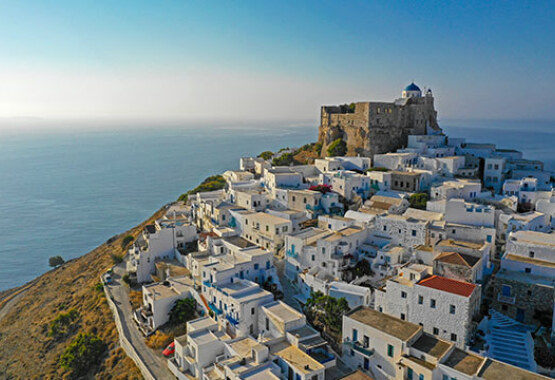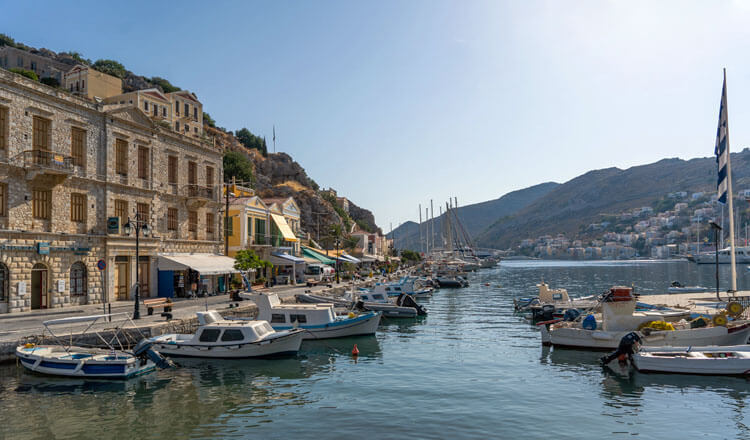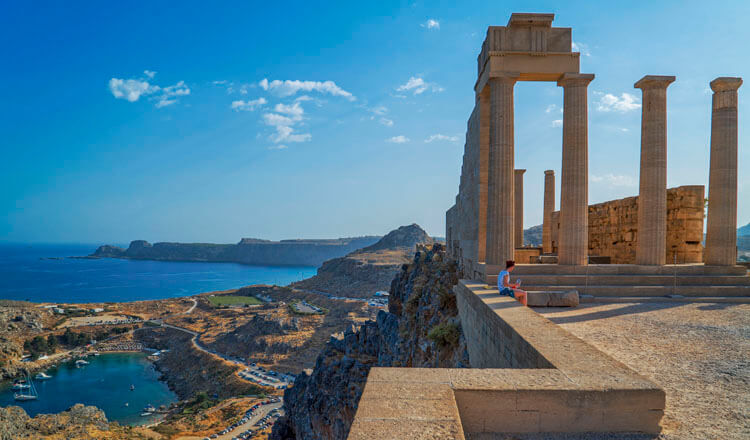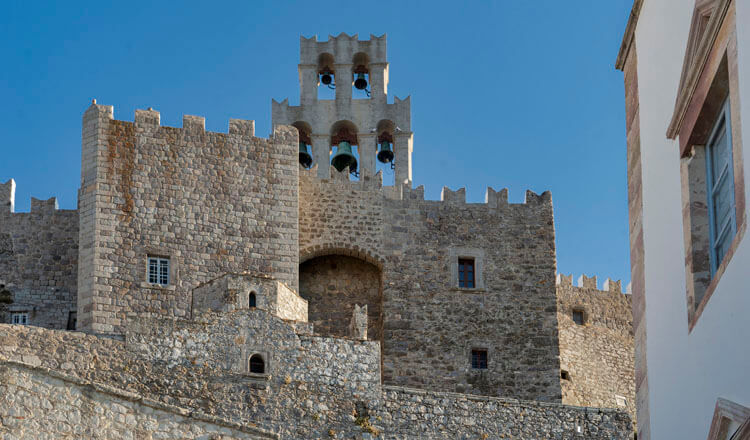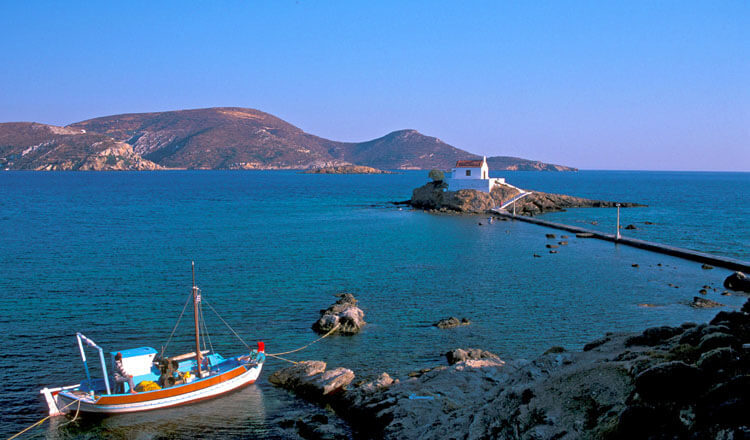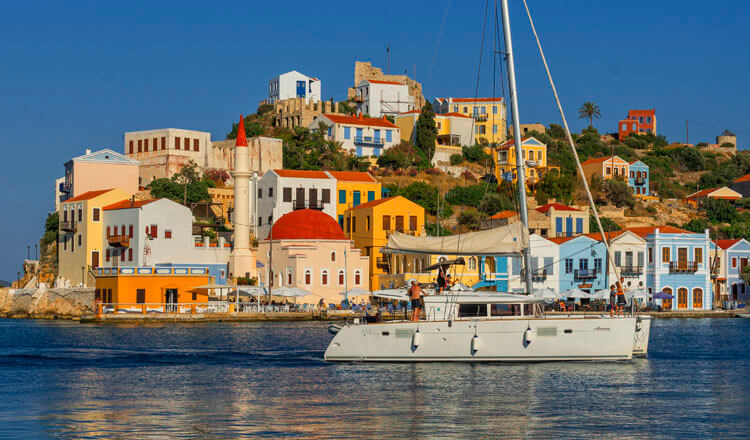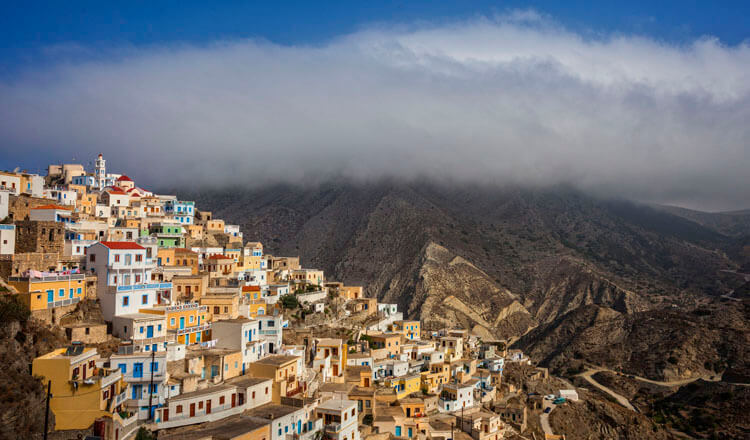Megalo Chorio
This is the island’s capital and it will impress you with its elegantly plain island-style architecture seen in its stone-built houses and narrow alleys, which are absolutely worth exploring on foot. On the hilltop you will see the mediaeval castle, built by the Knights of the Order of St. John, on the location of the island’s ancient acropolis. Inside the citadel you will see the remaining cisterns and ruins of buildings, such as the church of Taxiarchis [Archangel], built on the site of the ancient temples of Zeus Polieos and Athena Poliada.
Mesaria Castle (1366) is another mediaeval structure, which you will find on a hilltop between Megalo Chorio and Livadia village. Inside it, there are ruins of houses and the small church of Prophet Elias.
Visit the Archaeological Museum, and see the palaeontological (fossil) finds from Charkadio Cave and a small archaeological collection of pots, inscriptions, sculptures, etc, found on the island, as well as information on the excavations carried out in Charkadio Cave.
Take a trip to the cave (2km SE) and see the fossilised remains of deer and dwarf elephants who lived there between 45,000 and 4,000 years ago, as well as pottery and stone tools dating to the Neolithic Period (aka New Stone Age). The exhibits were unearthed in 1971. Megalo Chorio is 7 km NW of the harbour, which is in Livadia village.
Agios Antonios
This seaside village and its sheltered harbour (2 km W) is well-known and preferred by fishing and tourist boats. Make sure you visit the Byzantine monastery of Agios Panteleimonas (15th c.), located in a green area, with very tall cypress and plane trees (9 km SW). You will be impressed by the Byzantine murals and the 18th c. elaborate wood-carved icon screen.
Livadia
The village lies on the southeast coast, at the foot of the mountains that rise beyond its beach. In the horizon, you will see Symi Island, as well as the mountains of neighbouring Turkey. The island’s harbour is situated here and provides docking services to ferry and tourist boats. Walk along the streets of the village and find places to stay, and tavernas & cafés to enjoy your meal with a lovely beach view. Go for a swim at the large pebbly beach (next to the harbour), the waters are warm and crystal clear. If you’re lucky you will swim in the company of the European shag who prefers this beach.
Visit also the churches of Agios Nikolaos, Agios Georgios and Agia Anna (on Kastello Hill). At Misoskali location, within a small distance from the village, you can take a trip to the 14th c. Agios Nikolaos church, the 19th c. Panagia Politissa church, as well as Agios Petros and Pavlos church and see the impressive murals.
You will also be impressed by the building of the Police Station at Livadia, its amazing architectural style dates back to the island’s Italian occupation period (1912 - 1948). Continue your walk towards Agios Stefanos, a small mediaeval harbour and see the lighthouse. From Livadia, head up the mountain and visit the 15th c. Agiosykia Castle on the top. The picturesque Gera village and the Despoti Nero fountain will be your next stop, at only 2.5 km SE. Visit also the nearby 16th c. remarkable Taxiarchis Michail church. There is a path that leads to the church and it affords beautiful views of the countryside.
Mikro Chorio
The village was built in the 15th century on the hills rising above Livadia and it was deserted after WWII. A number of its inhabitants moved to Livadia village and started a new life there, as trading flourished in the harbour area. Today, you can see the ruins of a castle on the location, as well as the deserted stone-built houses, stone-paved streets, and Byzantine churches (Agios Ioannis Avdallas, Agia Zoni, Sotiras, etc.) with ancient murals and an incredible atmosphere.
In between the derelict houses, the centuries-old oak and olive trees are the silent witnesses of the island’s past, while offering sanctuary to the birds who make their nests there every spring.
Here’s a tip for your summer holidays on the island: Visit Mikro Chorio in the evenings, as it gets lively with the music being played at the local bar. The lights placed in the interiors of the old abandoned houses create a unique atmosphere. It stays open until the morning hours, providing the perfect setting for watching the sunrise.
Rocks and islets
Tilos Island is surrounded by 16 islets, the largest among them being Antitilos (SE) and Gaidaros (NW). Sail your boat or hire one at Livadia village, and visit the secluded shores and beaches of Tilos, as well as those of the nearby islands, where rare bird species build their nests.
